Tell el-Farkha (Ghazala) (Egypt)
The ninth season of the Polish Archaeological Expedition to the Eastern Delta ran from February 11 through May 18. The new trench cleared on the slope of the Western Kom in preparation for geophysical research this year covered 14 ares. The difference in levels was up to 2m, hence different chronological and cultural layers were explored at the same time. Yet the most important discoveries dated from the beginning of the First Dynasty, when this part of the site was abandoned. The northwestern corner of the new trench revealed a unit surrounded by walls 0.45m thick, quite possibly connected with the large building that has been interpreted as a public cult and administration center. Previously a deposit of miniature pottery and stone vessels had been found nearby (in 2001) and this was augmented this season by a collection of eight vessels, including a so-called Nubian bowl with dots and incised-triangle decoration. Scholars tend to connect vessels of this kind with ritual or cult practices of some kind. Two stone vessels and a palette with three round containers filled with a black substance (possibly ink?), were found directly below. A jar with the same dots and incised triangles as decoration, found lying by the east wall of the room and covered with an upturned bowl, provided the biggest surprise. Hidden inside it was a deposit of 62 objects. Made of hippopotamus ivory were five figurines of women, four of men, two of children, nine of dwarfs, two of fantastic creatures and 12 of different animals. The jar also contained 17 models – of a knife, boats, mirror, game counters, cylindrical seals, tablets and boxes – and 11 miniature vessels, made of a variety of stones, clay and copper, not to mention hippo tusks.
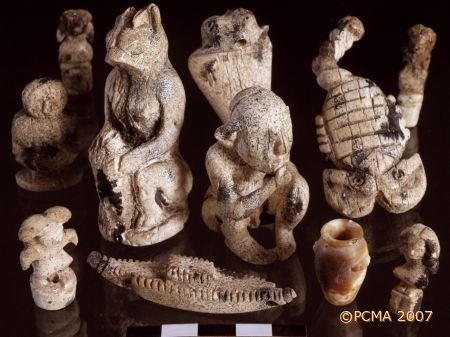
Up till now similar finds were only know from Tell Ibrahim Awad in Upper Egypt and the mission’s co-directors, Prof. Krzysztof M. Ciałowicz from the Jagiellonian University in Kraków and Dr. Marek Chłodnicki from the Archaeological Museum in Poznań, thought the discovery unparalleled until they explored level 29 in the northern trench on the Eastern Kom. Here, the architecture, although very much disturbed and destroyed by very intensive occupational activity in later times, proved of better substance than the rather poor settlement excavated so far. Two magnificent flint knives were found, worked with the highest mastery and precision. They were presumably used for ritual purposes. In the vicinity were fragments of gold sheet and these after careful scrutiny proved to be the covering of two standing male statues (about 60cm and 30cm high), originally made of wood which has not survived. Found together with these pieces of gold were two pairs of eyes of lapis lazuli and a necklace consisting of more than 300 white stone beads, 55 carnelian beads and an oval pendant of quartz. The finds have been dated tentatively to c. 3150 BC. None older than these have ever been found in Egypt. The rendering of details of the anatomy reveals an artist of the finest class and there can be little doubt that pieces of such artistry were the property of some wealthy aristocrat or belonged in a temple treasury.
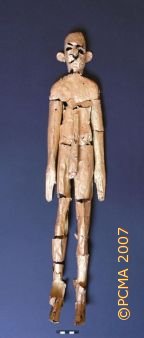
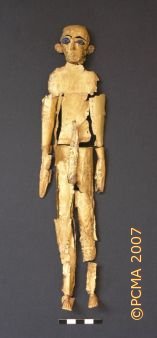
Excavations on the Eastern Kom also uncovered another 22 graves, mostly simple pits with few, if any grave equipment. Three of these originated from the Early Dynastic period and 17 were of Old Kingdom chronology (most likely the close of Dynasty III and beginning of Dynasty IV). The remaining two tombs were from the beginning and second half of the First Dynasty and they evidently belonged to a richer category. The pits were lined with mud brick and there were mud-brick superstructures, the entire chamber being covered with burial mats. The grave goods included abundant ceramic jars, bowls, storage jars and miniature vessels (a total of 27 and 37 respectively in the two tombs), but also alabaster and basalt bowls, bone spoons, carnelian beads, palettes of greywacke, a fragmentary clay seal and five models of granaries. Adult males had been buried in the two tombs.
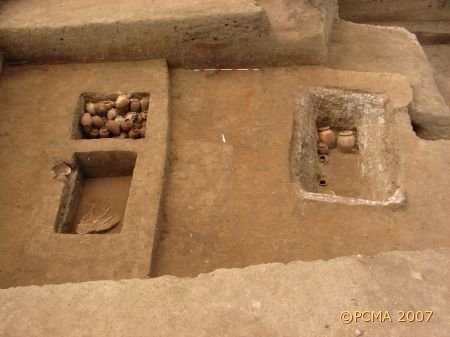
The discovered graves confirmed and complemented the results presented by Joanna Dębowska in her recent doctoral dissertation concerning the burial grounds on the Eastern Kom. Dębowska has interpreted the differences in the character of the three categories of tombs, which she defined, as representing a gradual political and social transformation of the population inhabiting Tell el-Farkha from prosperity and affluence to pauperization and decline.
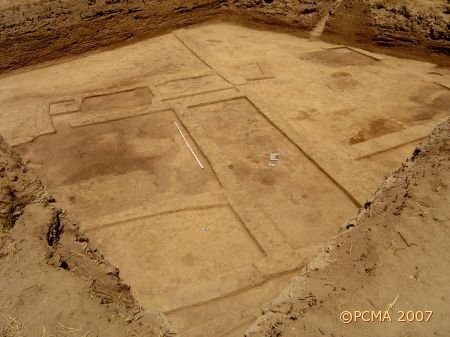
On the Central Kom investigations proceeded at their own pace, covering altogether an area of 690m2. Explorations of Naqadian buildings located around two squares and on either side of a thick wall cutting across the trench from northeast to southwest finished on the early Naqada IIIa-late Naqada IIb levels. Remnants of many hearths and ovens were registered inside the rooms and within the courtyards of the building.
